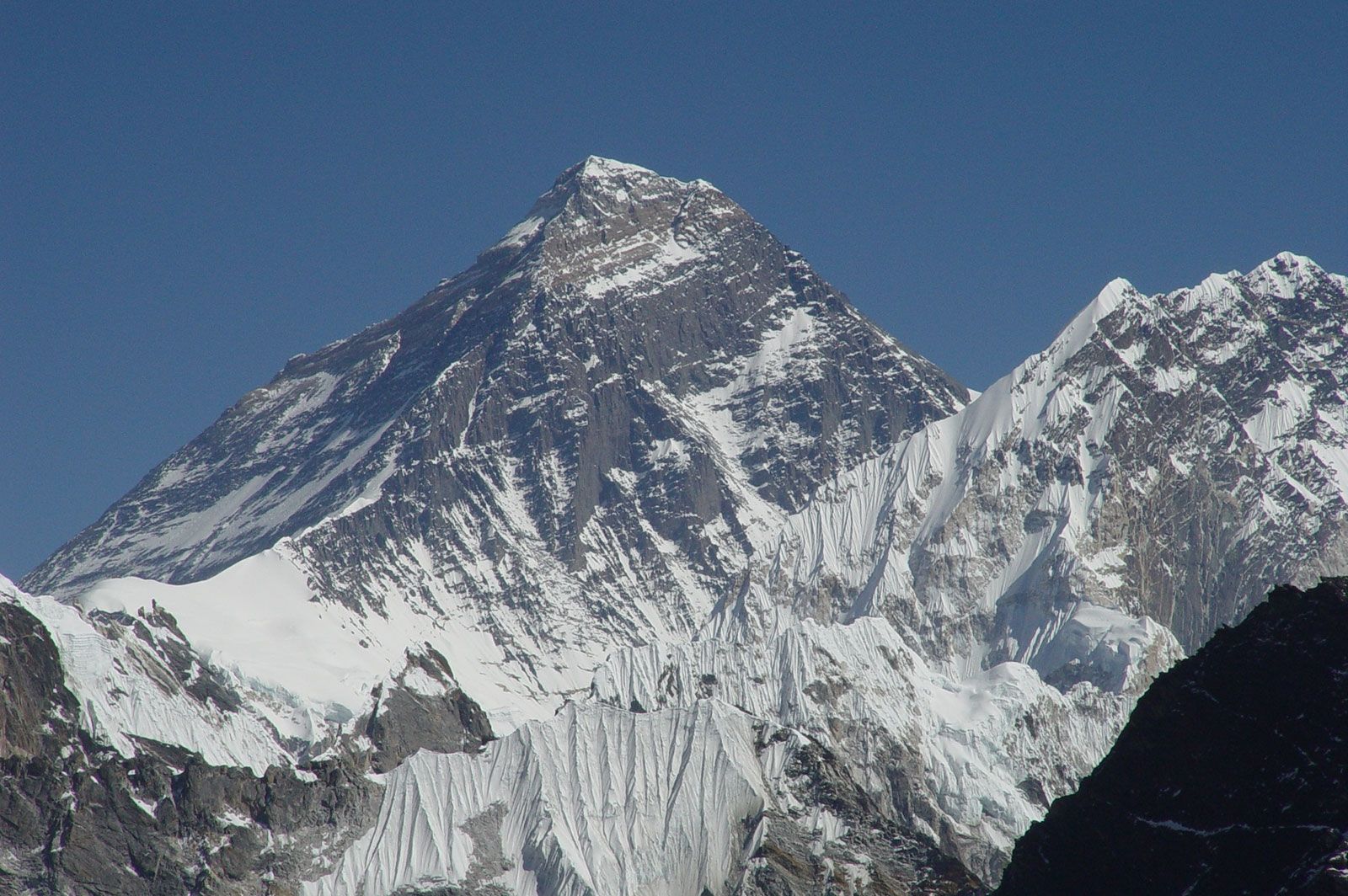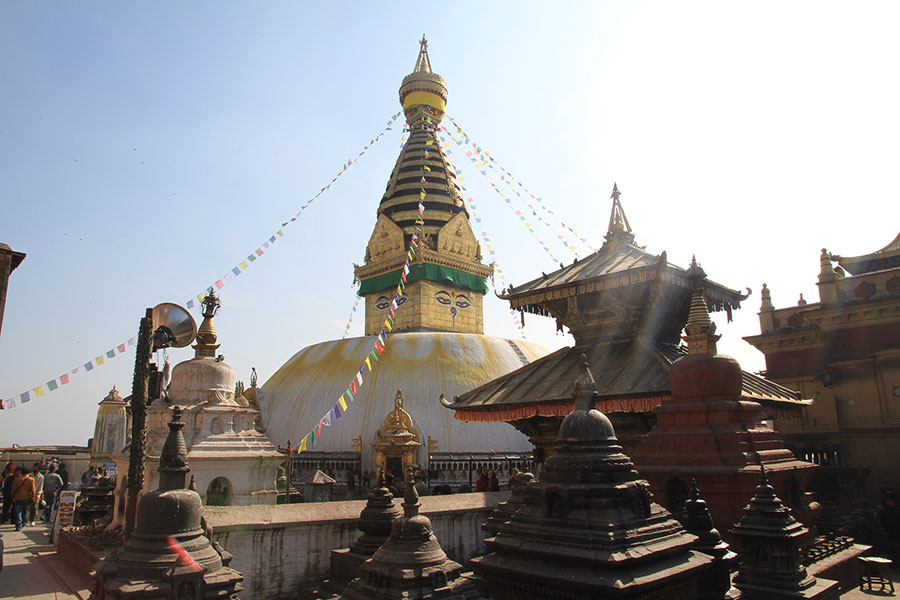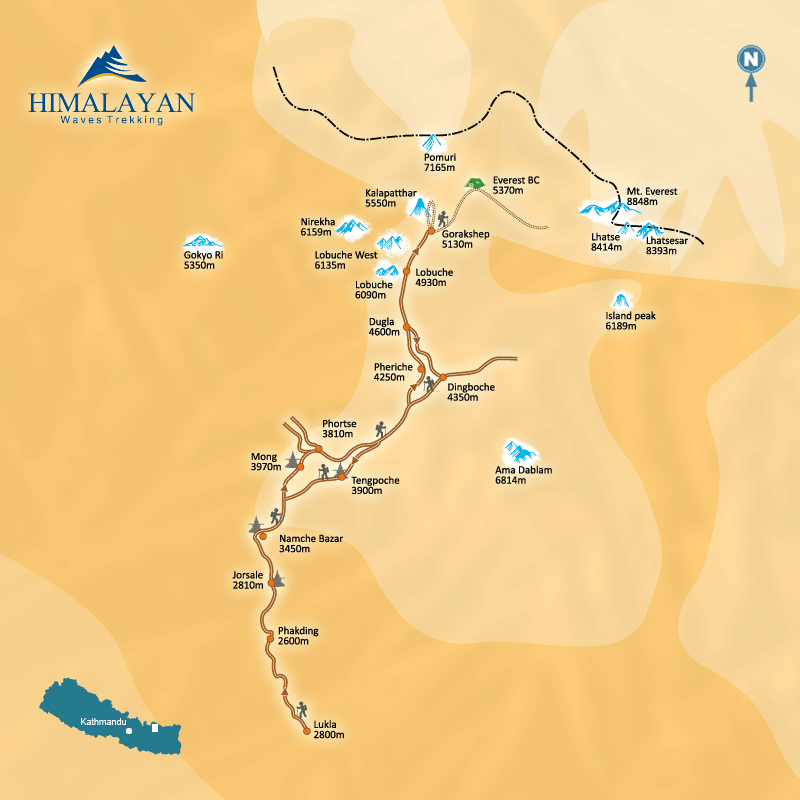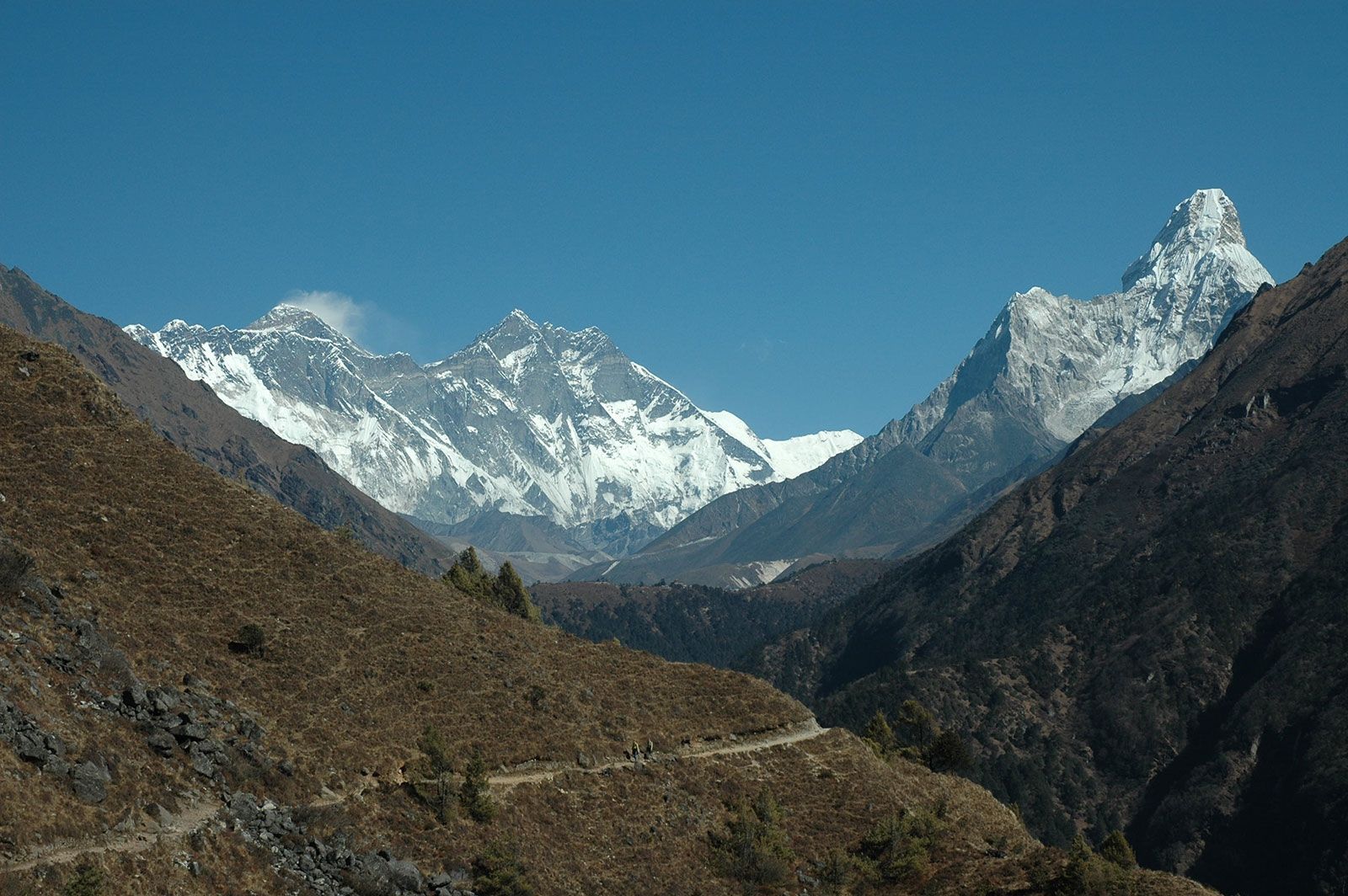-
SeasonsSpring / Summer / Autumn
Everest Base Camp Trek
-
Seasons:Spring / Summer / Autumn
Everest Base Camp Trek
Overview

Trip Fact
Price
Duration
Altitude
Group Size
Accommodation
Trip Start From
Trip Ends At
Why Choose This Trip?
1. Stand Among Giants: Discover Earth’s Most Iconic Mountain Vistas
Imagine waking up to the golden glow of the Himalayas lighting up the sky—Mount Everest rising above everything, flanked by Lhotse, Nuptse, and the stunning Ama Dablam. This is the Everest Base Camp trek: a journey through some of the planet’s most jaw-dropping landscapes.
From lush rhododendron forests to windswept alpine trails, every step through Sagarmatha National Park (a UNESCO World Heritage Site) feels like you’ve stepped into a nature documentary. And the sunrise from Kala Patthar? Simply unforgettable. Everest, bathed in gold, is pure magic.
2. Dive Into Sherpa Culture & Himalayan Way of Life
Everest Base Camp Trek isn’t just about mountains—it’s about the people who call them home. You’ll wander through the heart of Sherpa country, where spirituality, resilience, and tradition come together in the most inspiring ways.
You’ll visit sacred spots like Tengboche Monastery, hear monks chant with Mount Everest behind them, explore the lively market town of Namche Bazaar, and warm up in teahouses over steaming bowls of dal bhat. These moments give the trek depth—connecting you not just to the landscape, but to its soul.
3. Push Yourself—And Feel More Alive Than Ever
Let’s be real: Everest Base Camp Trek is no walk in the park. You’ll cover 130 kilometers over 12 to 14 days, climb above 5,000 meters, and push through moments of exhaustion. But every challenge is matched with awe.
When you finally reach Base Camp, surrounded by the peaks of legends, the pride and emotion you’ll feel is overwhelming. It’s not just about reaching a place on the map—it’s about discovering how strong, capable, and alive you really are.
4. Follow in the Footsteps of Legends
You’ll be walking the same path that Sir Edmund Hillary and Tenzing Norgay once took. The trail is steeped in stories—starting with Lukla’s famously wild airstrip, winding past the ghostly beauty of the Khumbu Icefall, and moving through solemn memorials to climbers who never returned.
It’s humbling. Powerful. And it reminds you: this place is not just a destination—it’s sacred ground.
5. Share the Journey, Forge Lifelong Friendships
One of the best parts of the Everest Base Camp Trek? The people you meet along the way. Strangers become friends as you share trail mix, trade stories over hot tea, and cheer each other on across swaying suspension bridges strung with prayer flags.
Whether you’re laughing over dinner in a cozy teahouse or celebrating with a mug of hot chocolate at Gorak Shep, these shared moments are the ones you’ll carry home with you—alongside the views, the photos, and that feeling of having truly done something extraordinary.
Trip At Glance
Brief Itinerary
-
Day 01:Arrival in Kathmandu, meet at the airport and transfer to Hotel
-
Day 02:Fly Kathmandu – Lukla (2800 m), overnight at Phakding (2600 m)
-
Day 03:Namche Bazar (3450 m)
-
Day 04:Acclimatisations Day
-
Day 05:Phortse (3810m) via Cross Mong
-
Day 06:Pheriche (4250 m)
-
Day 07:Acclimatisations Day
-
Day 08:Dugla (4600 m)
-
Day 09:Lobuche (4930 m)
-
Day 10:Everest Base Camp (5500 m), overnight at Gorak Shep (5130 m)
-
Day 11:Kala Pattar (5550 m), overnight at Dingboche (4350 m)
-
Day 12:Tengboche (3900 m)
-
Day 13:Jorsale (2810 m)
-
Day 14:Lukla (2800 m)
-
Day 15:Fly Lukla – Kathmandu, transfer to Hotel
-
Day 16:Kathmandu – leisure day and evening farewell dinner
-
Day 17:Departure to connect next destination or you may extend the trip as per your desire and time
Detailed Itinerary
Day 1: Arrival in Kathmandu, meet at the airport and transfer to Hotel
Upon arrival in Kathmandu, you’ll be warmly welcomed at Tribhuvan International Airport and transferred to your hotel. After check-in, you can relax from your journey or take a short stroll through Thamel’s vibrant streets to get a taste of the local culture.

Day 2: Fly Kathmandu – Lukla (2800 m), overnight at Phakding (2600 m)
You’ll fly from Kathmandu to Lukla (≈ 2,800 m), a thrilling 30–40‑minute flight into the heart of the Khumbu region. From Lukla, trek gently downhill and through villages, suspension bridges, prayer stones and terraces to reach Phakding (≈ 2,600 m) for your first night in the Everest foothills.
Day 3: Namche Bazar (3450 m)
Trek along riverbanks and lush forest through villages like Benkar and Monjo, entering Sagarmatha National Park. The trail climbs steadily, offering your first real taste of the Everest scenery as you arrive in bustling Namche Bazaar at ≈ 3,450 m.
Day 4: Acclimatisations Day
A full acclimatization day in Namche, where you can explore monasteries, visit the Sherpa museum, and take short hikes to viewpoints offering panoramic Himalayan vistas—essential preparation before ascending higher.
Day 5: Phortse (3810m) via Cross Mong
Climb over the Mong La ridge and along panoramic hills to reach Phortse (≈ 3,810 m). This scenic route through remote Sherpa villages gives you sweeping views of Ama Dablam and surrounding peaks..
Day 6: Pheriche (4250 m)
Ascend steadily to Pheriche at around 4,250 m, passing through grazing lands and occasional yak herders. Pheriche also hosts an altitude monitoring medical clinic run by the Himalayan Rescue Association.
Day 7: Acclimatisations Day
Another acclimatization day—but at higher elevation in Pheriche. You can hike locally to explore the Khumbu slopes or rest to let your body adapt to the thin air.
Day 8: Dugla (4600 m)
Continue upward to Dugla (≈ 4,600 m), passing glacial fields and troughs. The terrain gets rockier and sparser, and you’ll sense the altitude bite above tree line.
Day 9: Lobuche (4930 m)
Trek from Dugla to Lobuche (≈ 4,930 m), a long, gradual ascent over moraines that brings you ever closer to the Everest massif. The quiet, windswept settlement is nestled beneath lofty peaks.
Day 10: Everest Base Camp (5500 m), overnight at Gorak Shep (5130 m)
Set out early for the trek to Everest Base Camp at around 5,500 m. After soaking in the views of the Khumbu Icefall, descend to Gorak Shep (≈ 5,130 m) and settle in for the night amid the jagged peaks and glacial vistas
Day 11: Kala Pattar (5550 m), overnight at Dingboche (4350 m)
Pre‑dawn hike to Kala Patthar (≈ 5,550 m), one of the best vantage points to view Everest, Lhotse, Nuptse and more. The climb takes about 1½–2 hours. After sunrise and photos, descend steeply to Dingboche (≈ 4,350 m) for the night.
Day 12: Tengboche (3900 m)
Leave Dingboche heading downhill through pine forest, arriving at Tengboche (≈ 3,900 m). You’ll pass the famous Tengboche Monastery perched high on a ridge, an iconic spiritual and photographic-stop.
Day 13: Jorsale (2810 m)
Descend further to Jorsale (≈ 2,810 m), crossing the legendary high suspension bridge over Dudh Koshi River and retracing steps through Monjo before reaching this valley settlement.
Day 14: Lukla (2800 m)
Trek onwards to Lukla (≈ 2,800 m) through verdant forest pathways and familiar villages. It’s your final trekking day in the mountains, walking with both accomplishment and relief.
Day 15: Fly Lukla – Kathmandu, transfer to Hotel
Fly from Lukla back into Kathmandu. After landing, be transferred to your hotel where city comforts and a warm cultural welcome await.
Day 16: Kathmandu – leisure day and evening farewell dinner
Final leisure time followed by a farewell dinner. Experience traditional Sherpa cuisine and cultural performances as you celebrate the completion of your Himalayan journey.
Day 17: Departure to connect next destination or you may extend the trip as per your desire and time
After breakfast, transfer to the airport for departure or optionally extend your stay to explore further in Nepal.
Package Details
Cost Includes:
- Airport arrival and departure private transfer
- 3 nights accommodation in Kathamndu with breakfast on twin share basis
- Kathmandu – Lukla – Kathmandu flight ticket for guest and guide
- 13 nights full board (BLD) teahouse trek with accommodation in mountain
- An english speaking trekking guide and porters from Lukla (2 guests = 1 Porter & Max 25 kg)
- National Park Entrace Permit and TIMS (required passport copy and 2 picture for permit)
- Farewell dinner with Nepalese cultural dance show.
Cost Excludes:
- Personal nature of expenses and trekking gears
- Airport taxes and excess baggage fee ( 20KG free)
- Travel Insurance for rescue operation if any form
- Extra night accommodation or accommodation if earlier return from trekking by any reason
- Extra cost occur by any reason which is not in our control such as strike, landslide and accident etc
- TIPS for trekking staffs and other things which is not included above.
To Do’s In Kathmandu
- Walk Through History at UNESCO Sites
Kathmandu Valley offers an unforgettable journey through history with UNESCO World Heritage Sites like Swayambhunath, Boudhanath, Pashupatinath, and the ancient Durbar Squares—each filled with rich culture, architecture, and spiritual depth. - Shop, Eat & People-Watch in Thamel
Thamel is the buzzing heart of Kathmandu where you can shop for trekking gear, local crafts, and books, or relax in rooftop cafés and enjoy a wide mix of global and local food. - Taste the Real Nepal (Beyond Dal Bhat)
Kathmandu’s food scene delivers everything from juicy momos and traditional Newari dishes to hearty Thakali thalis, making it a top spot for tasting Nepal’s diverse culinary flavors. - Easy Day Trips When You Need a Break from the Buzz
Short escapes to places like Bhaktapur, Nagarkot, Dhulikhel, or Chandragiri offer peaceful views, cultural depth, and refreshing air—all within a quick drive from the city. - Recover, Recharge & Just Chill
After a trek or long journey, Kathmandu is perfect for recovery with spas, yoga studios, serene gardens, and rooftop lounges that help you unwind at your own pace.
FAQs
Plan your Trip
Sangeeta Bhandari
sangeeta@himalayanwavestrekking.com
Quick Inquiry
Write Your Review
We’d love to hear your thoughts! Please leave a star rating and share your review of this trek.











